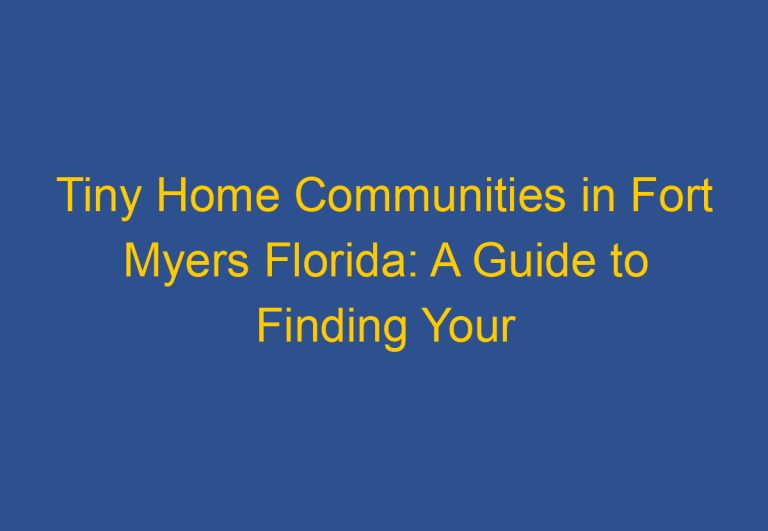Tiny Home Communities in Bay Area: A Guide to Finding Your Perfect Community
The Bay Area has long been known for its high cost of living, with housing being one of the biggest expenses for residents. In recent years, the tiny home movement has gained popularity as a more affordable and sustainable way of life. Tiny homes are typically less than 400 square feet and can be built on wheels or on a foundation.
Tiny home communities in the Bay Area have become a solution for those seeking a more affordable and minimalist lifestyle. These communities offer a sense of community and shared values, as well as access to communal spaces and resources. Many tiny home communities in the Bay Area are also focused on sustainability, with features such as solar panels and composting toilets.
Living in a tiny home community in the Bay Area can provide a unique and rewarding experience for those who value simplicity, community, and sustainability. From communal gardens to shared kitchens, these communities offer a way of life that is both affordable and environmentally conscious. With the rising cost of living in the Bay Area, tiny home communities are becoming an increasingly popular option for those seeking a more affordable and sustainable way of life.
The Rise of Tiny Home Communities in the Bay Area
Understanding the Tiny House Movement
The tiny house movement has been gaining popularity in recent years as people look for more sustainable and affordable living options. Tiny houses are typically less than 400 square feet and are designed to be functional and efficient, making them an attractive option for those looking to downsize or live a minimalist lifestyle.
Benefits of Tiny Living in Northern California
In Northern California, where housing costs are notoriously high, tiny homes offer an affordable alternative. With a smaller footprint, tiny homes require less energy to heat and cool, making them more environmentally friendly and cost-effective. Additionally, many tiny home communities are designed to foster a sense of community and shared values among residents, creating a tight-knit and supportive living environment.
Legal Tiny House Communities
While regulations surrounding tiny homes can be complex, there are several legal tiny house communities in the Bay Area. These communities offer a unique living experience, with shared amenities and a strong sense of community. Residents of legal tiny house communities can enjoy the benefits of tiny living without the legal risks associated with living in an illegal dwelling.
In summary, the rise of tiny home communities in the Bay Area is a trend that is here to stay. With the benefits of affordability, sustainability, and community, more and more people are turning to tiny homes as a viable housing option. As regulations surrounding tiny homes continue to evolve, it is likely that we will see even more legal tiny house communities in the future.
Design and Sustainability Features
Innovative Tiny House Designs
When it comes to designing tiny homes, there are a variety of creative solutions that can be employed to make the most of limited space. For example, many tiny home designs incorporate multi-functional furniture, such as couches that double as storage units or beds that fold up into walls. Additionally, some tiny homes use lofted sleeping areas to maximize floor space, while others have built-in storage solutions that make use of every nook and cranny.
Energy Efficiency and Carbon Footprint
One of the biggest benefits of living in a tiny home is the reduced carbon footprint that comes with a smaller living space. Many tiny homes are also designed with energy efficiency in mind, incorporating features such as solar panels, rainwater collection systems, and composting toilets. These sustainable features not only help to reduce the environmental impact of tiny homes, but can also save homeowners money on utilities in the long run.
Utilizing Small Spaces Effectively
When designing a tiny home, it’s important to make the most of every square inch of space. This means incorporating storage solutions that are both functional and aesthetically pleasing, such as built-in shelves, cabinets, and drawers. Additionally, choosing the right materials for insulation, siding, and other aspects of the home can help to maximize energy efficiency and create a comfortable living space that is both nontoxic and safe.
Overall, the design and sustainability features of tiny homes are a major factor in their growing popularity. By utilizing innovative design solutions and incorporating sustainable features, tiny homes are able to provide a comfortable, functional living space that is both eco-friendly and cost-effective.
Community and Lifestyle
Amenities in Tiny Home Communities
One of the biggest benefits of living in a tiny home community is the access to quality amenities. Many communities have a pool, tennis courts, and other recreational facilities that residents can use. These amenities are often included in the cost of living in the community, making it an affordable way to enjoy a high standard of living.
The Social Aspect of Tiny Living
Living in a tiny home community can also be a great way to meet new people and build strong relationships. Many communities have regular events and activities that bring residents together, such as potlucks, game nights, and movie screenings. These events provide a great opportunity to get to know your neighbors and build a sense of community.
Recreational Activities and Services
In addition to the amenities and social events, many tiny home communities also offer a range of recreational activities and services. For example, some communities have fishing and boating facilities, while others have a dog park or community garden. These activities and services allow residents to enjoy a range of hobbies and interests, and contribute to the overall sense of community.
Overall, living in a tiny home community can be a great way to enjoy a high quality of life while building strong relationships with your neighbors. With access to quality amenities, regular social events, and a range of recreational activities and services, tiny home communities offer a unique and fulfilling lifestyle that is well worth considering.
Real Estate and Legal Considerations
Living in a tiny home can be an attractive option for those looking for affordable housing in the Bay Area. However, before making the move, it is important to consider the real estate and legal implications of tiny home living.
Zoning Laws and Building Codes
Zoning laws and building codes vary by city and county in the Bay Area, and it is important to research and understand these regulations before purchasing or building a tiny home. In some areas, tiny homes may be classified as accessory dwelling units (ADUs) and subject to specific regulations. In other areas, they may be considered recreational vehicles (RVs) and only allowed in designated RV parks.
Ownership vs. Rental Options
Another important consideration is whether to own or rent a tiny home. While owning a tiny home can provide a sense of freedom and control, it also comes with the responsibility of maintaining and securing the property. Renting a tiny home may be a more affordable option, but it also means giving up some level of control over the living space.
The Impact on Local Housing Markets
Tiny homes are often seen as a solution to the Bay Area’s housing shortages, but their impact on local housing markets is still unclear. While they may provide affordable housing options for some, they may also contribute to the overall gentrification and displacement of low-income communities.
In addition, tiny homes may have an impact on property values and tax bills. Depending on the location and classification of the tiny home, property taxes and other fees may apply. It is important to research and understand these costs before making the move to a tiny home community.
Overall, while tiny homes can offer an affordable and sustainable housing option in the Bay Area, it is important to carefully consider the real estate and legal implications before making the move. By understanding zoning laws, ownership options, and the impact on local housing markets, individuals can make informed decisions about whether tiny home living is right for them.
Frequently Asked Questions
How do I find tiny home communities in the Bay Area for sale?
There are a variety of ways to find tiny home communities for sale in the Bay Area. One option is to search online real estate listings or contact a local real estate agent who specializes in tiny homes. Another option is to attend tiny home events or workshops, where you can meet with builders and community organizers who can provide information about available properties.
What are the options for renting in tiny home communities in the Bay Area?
Renting a tiny home in a community can be a great way to experience the lifestyle without the commitment of buying a property. Many tiny home communities offer rental options, ranging from short-term stays to long-term leases. Some communities also offer the option to rent a plot of land and build your own tiny home.
Can you provide information on permanent tiny home communities in Northern California?
There are several permanent tiny home communities in Northern California, including the Tiny House Village in Sonoma County and the Lake County Tiny Home Village. These communities offer a range of amenities and services, including communal spaces, gardens, and workshops.
What are the legal requirements for living in a tiny house in the Bay Area?
The legal requirements for living in a tiny house in the Bay Area vary depending on the location and type of property. In general, tiny homes must comply with local zoning and building codes, which may require permits and inspections. It is important to research the specific requirements for your chosen community and consult with a legal professional if necessary.
Where is the first tiny cabin village located in San Francisco?
The first tiny cabin village in San Francisco is located in the Bayview neighborhood. The village, which is operated by the nonprofit organization Safe Haven Community, provides transitional housing for homeless individuals in the city.
How do tiny home communities near Sacramento compare to those in the Bay Area?
Tiny home communities near Sacramento offer a similar lifestyle to those in the Bay Area, with a range of amenities and services available. However, the cost of living and property prices may be lower in Sacramento and surrounding areas, making it a more affordable option for some individuals. It is important to research and compare different communities to find the best fit for your needs and budget.












